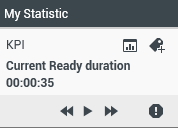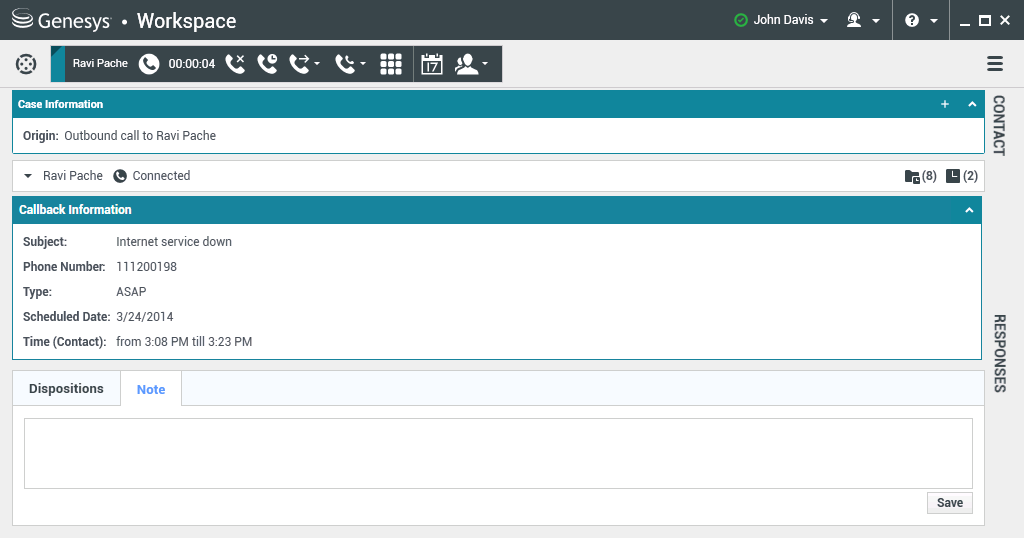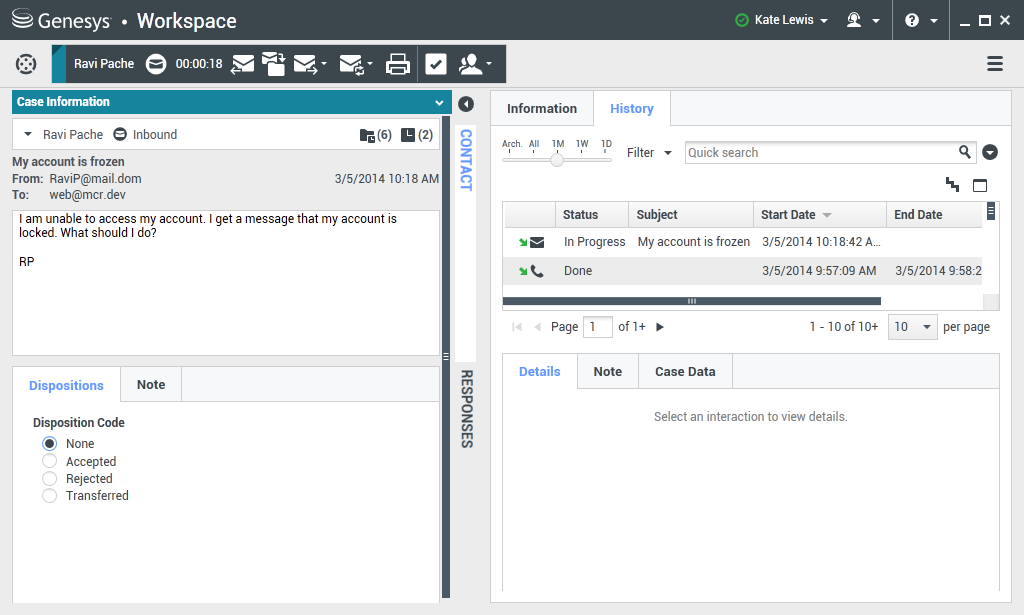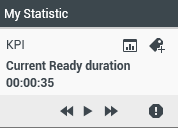Contents
- 1 Workspace Windows and Views
- 1.1 Views, Windows, Components, Features, and Control Overview
- 1.2 Workspace Main Window
- 1.3 Voice Interaction Window
- 1.4 Web Callback Interaction Window
- 1.5 Outbound Campaign Voice Interaction Window
- 1.6 Email Interaction Window
- 1.7 Chat Interaction Window
- 1.8 SMS Interaction Window
- 1.9 IM Interaction Window
- 1.10 Statistics Gadget
Workspace Windows and Views
Workspace displays on your workstation desktop a set of Views and Windows, that contain the components, features, and controls that enable you to perform the tasks that are assigned to you, based on your privileges. The Views and Windows enable you to perform multiple functions, such as previewing and accepting interactions; or managing your status, settings, and contacts. Atomic views typically enable you to perform a single function, such as viewing case information or specifying a disposition code.
Some views, such as the Case Information view, are displayed in separate windows. Other views are part of a window, such as the Voice Interaction window; these are displayed in one window along with other components, features, and controls .
Refer to the Workspace Desktop Edition Help for details on the functionality in each window and view.
Views, Windows, Components, Features, and Control Overview
- Login Window--The first view that you see (see Log In). It enables you to identify yourself and, if required, enter additional login data, based on your role or on the technical environment.
- Main Window--Enables you to manage your status, contacts, and settings; view your Key Performance Indicators (KPIs) and system messages; and launch new interactions.
- Statistics Gadget--Enables you to view your KPIs and Contact Center Statistics in a permanent view. Statistics can be viewed in a ticker and/or in a static view.
- Interaction Preview--Displays an interactive notification of a new inbound interaction. The preview includes case information to enable you to decide whether to accept, reject, or redirect the interaction (see Handling Voice Interactions).
- Voice Interaction Window--Enables you to view all of the information that is necessary to handle a voice interaction with a contact. This window also contains information about contacts and the Team Communicator.
- Web Callback--Enables you to view all of the information that is necessary to handle a Web Callback voice interaction with a contact.
- Outbound Campaign--Enables you to view all of the information that is necessary to handle an Outbound Campaign voice interaction with a contact.
- Consultation--Enables you to initiate a call to an internal expert or support person. It is part of the Team Communicator functionality.
- E-Mail--Enables you to view all of the information that is necessary to handle an email interaction with a contact.
- Chat--Enables you to view all of the information that is necessary to handle a chat interaction with a contact.
- SMS--Enables you to view all of the information that is necessary to handle an SMS Page interaction or an SMS Session interaction with a contact.
- Workitems--Documents that might be directed to you for handling. They include numerous non-interactive media types, such as faxes, that you might have to view while you are handling interactions of another type, such as email.
- Internal IM--Enables you to initiate an Instant Messaging (IM) session with an internal expert or support person. It is part of the Team Communicator functionality.
- History--Enables you to view case data (business context of the case). Compiles the attached data that is associated with the main interaction of the case into a Case History (see Manage Contacts). It is part of Workspace functionality for processing voice interactions as well as other media types.
Components, Features, and Controls
The Workspace Components, Features, and Controls are mapped to privileges. They enable you to perform single-step tasks, provide you with one or two functional options, and provide you with information that supports your current task. Components, Features, and Controls are usually contained within a View, but they might also be displayed in stand-alone windows or panels. Components, Features, and Controls behave like mini-applications. You can hide or show them and expand them or collapse them by clicking buttons in the View or Window in which they are contained. Refer to the Workspace 8.5 Help for details on the functionality in each window and view.
The following Components, Features, and Controls are included in Workspace; however, through customization, many more can be created:
- Case Information--Provides you with critical information about the active interaction. The information that is provided is configured by your system administrator.
- Contact Summary--Provides you with critical information about the contact who is involved in the active interaction.
- Voice Media--Enables you to control the active voice interaction or start a new interaction.
- Voice Internal--Enables you to control the active internal voice interaction or start a new internal interaction.
- Case Toolbar--Enables you to hold, connect, and end current interactions.
- Dispositions--Enables you to assign one or more codes to an ongoing or terminated interaction to qualify or characterize the outcome of the interaction, and a call result for outbound campaign interactions.
- Note View--Enables you to record information about the current interaction.
- History List--Enables you to view the history of interactions with the selected contact.
- History Interaction Details--Enables you to view the details of previous interactions with the selected contact.
- Contact Record--Enables you to view information about contacts that has been collected by your contact center.
- Responses--Enables you to access a database of pre-written standard responses for your interactions. You can insert these responses as replies into any email or chat message, or you can read them to the contact during a phone interaction. You might be configured to use suggested responses that are rated according to their relevancy to the content of the inbound interaction.
- Team Communicator--Enables you to call an internal target or contact, start a conference, or transfer the current interaction.
- Child Interaction Navigator--Enables you to view and select any "child" interactions that you have initiated that relate to the current customer interaction (the parent interaction), such as an internal consultation call or a chat with another agent.
- IM Media--Enables you to initiate or receive Instant Messaging (IM) interactions.
- My Status--Enables you to monitor the status of your media channels.
- My Messages--Provides you with up-to-date information about the status of your contact center, changes that are related to your activities, and business messages that your leads send to you.
- Workbins--Enables you to store email and other interactions that are to be handled later. Interactions that are stored in a workbin can be accessed in any order. Items that are stored in a workbin are owned by the owner of the workbin.
- Preferences--Enables you to control the appearance of various Workspace interface components.
- Recent Items--Enables you to select a recent contact from a drop-down list.
- My Campaigns--Provides you with a list of all of your active Outbound Campaigns. If you are part of a pull-preview campaign, you can get a new campaign record.
- My History--Enables you to view a record of your recent activity.
- My Statistics--Enables you to view your Key Performance Indicators (KPIs).
- Contact Center Statistics--Enables you to view the statistics of your contact center.
- Schedule a Callback--Enables you to set a later date and/or time to callback a contact from a campaign list.
Workspace Main Window
The Workspace Main Window (see the Workspace Main Window figure) is a module that enables you to manage your channels, status, KPIs, contacts, workbins, and campaigns. It can be used to initiate interactions, either directly or through a search of the contact database and interaction history. The Main Window supports simultaneous interactions on one or more channels and provides the interaction Preview interactive notification. You can use the Main Menu to set preferences, launch Help, display the Statistics Gadget, and exit the application. For more information about the functions that are available in the Main Window, see the following lessons:
- Docking, Undocking, and Auto-hiding--Main Window Basics
- Go Ready--Manage Your Status
- Set a Forwarding Number--Forward Your Calls
- Find an Internal Target or a Contact--Find A Contact Or An Internal Target
- Call an Internal Target or a Contact--Handle Voice Interactions
- IM an Internal Target--Handle Internal Instant Messaging
- E-Mail a Contact--Handle An E-Mail Interaction
- Manage Workbins--Using Workbins
- Manage Contacts--Manage Contacts
- View Statistics--View KPIs And Statistics
- Receive Messages--Receive Business And System Messages
- Change the Appearance of Interface--Personalize Your Workspace
Voice Interaction Window
The Voice Interaction window (see the Workspace Voice Interaction window figure) and the Web Callback Interaction window enable you to view all of the information that is required to handle a voice interaction with a contact or an internal target.
You can view call status, history, and case data. You can control the call, conference or transfer the call, enter notes about the call, and send DTMF.
For more information about the functions that are available in the Voice Interaction window, see the following lessons:
- Find an Internal Target or a Contact--Find A Contact Or An Internal Target
- Call an Internal Target or a Contact--Handle Voice Interactions
- Start a Voice or IM Consultation--Handle A Voice Consultation
- Transfer to an Internal Target or a Contact--Transfer A Voice Call
- Conference with an Internal Target or a Contact--Conference A Voice Call
- Transition an IM Consultation to a Voice Consultation--Blend Different Media Into A Single Conversation
- Record a Call--Record Interactions
- Set a Disposition Code--Apply Disposition Codes
- Manage Contacts, Contact Case History, and Set a Note--Manage Contacts
- Use Standard Responses--Using The Standard Response Library
Web Callback Interaction Window
The Web Callback Interaction window enables you to view all of the information that is required to handle a web callback interaction with a contact (see the Workspace Voice Interaction window figure).
You can view call status, history, and case data. You can control the call, conference or transfer the call, enter notes about the call, and send DTMF.
For more information about the functions that are available in the Voice Interaction window, see the following lessons:
- Find an Internal Target or a Contact--Find A Contact Or An Internal Target
- Call an Internal Target or a Contact--Handle Voice Interactions
- Handle a Web Callback interaction--Handle Web Callback Interactions
- Start a Voice or IM Consultation--Handle A Voice Consultation
- Transfer to an Internal Target or a Contact--Transfer A Voice Call
- Conference with an Internal Target or a Contact--Conference A Voice Call
- Transition an IM Consultation to a Voice Consultation--Blend Different Media Into A Single Conversation
- Record a Call--Record Interactions
- Set a Disposition Code--Apply Disposition Codes
- Manage Contacts, Contact Case History, and Set a Note--Manage Contacts
- Use Standard Responses--Using The Standard Response Library
Outbound Campaign Voice Interaction Window
The Outbound Campaign Voice Interaction window (see the Workspace Outbound Campaign Voice Interaction window figure) enables you to view all of the information that is required to handle an Outbound Campaign voice interaction with a contact.
You can view call status, history, case data, and record information. You can control the call, conference or transfer the call, enter notes about the call, and send DTMF.
For more information about the functions that are available in the Outbound Campaign Voice Interaction window, see the following lessons:
- Find an Internal Target or a Contact--Find A Contact Or An Internal Target
- Call an Internal Target or a Contact--Handle Voice Interactions
- Transfer to an Internal Target or a Contact--Transfer A Voice Call
- Conference with an Internal Target or a Contact--Conference A Voice Call
- Handle an Outbound Campaign Voice Interaction (including Rescheduling a call)--Handle Outbound-Campaign Voice Interactions
- Record a Call--Record Interactions
- Set a Disposition Code--Apply Disposition Codes
- Manage Contacts and Contact Case History--Manage Contacts
- Use Standard Responses--Using The Standard Response Library
Email Interaction Window
The Email Interaction window (see the Workspace E-Mail Interaction window figure) enables you to view all of the information that is required to handle an email interaction with a contact.
You can view information about the email, history, and case data. You can reply to the interaction, save to a workbin, transfer the interaction, start a conference, and enter notes about the interaction.
For more information about the functions that are available in the E-Mail Interaction window, see the following lessons:
- Find an Internal Target or a Contact--Find A Contact Or An Internal Target
- Call an Internal Target or a Contact--Handle Voice Interactions
- Start a Voice or IM Consultation--Handle A Voice Consultation
- Transfer to an Internal Target or a Contact--Transfer A Voice Call
- Transition an IM Consultation to a Voice Consultation--Blend Different Media Into A Single Conversation
- Set a Disposition Code--Apply Disposition Codes
- Manage Contacts and Contact Case History--Manage Contacts
- Use Standard Responses--Using The Standard Response Library
Chat Interaction Window
The Chat Interaction window (see the Workspace Chat Interaction window figure) enables you to view all of the information that is required to handle a chat interaction with a contact.
You can view chat status, history, and case data. You can control the interaction, start a conference, transfer the interaction, and enter notes about the interaction.
For more information about the functions that are available in the Chat Interaction window, see the following lessons:
- Find an Internal Target or a Contact--Find A Contact Or An Internal Target
- Call an Internal Target or a Contact--Handle Voice Interactions
- Start a Voice or IM Consultation--Handle A Voice Consultation
- Transfer to an Internal Target or a Contact--Transfer A Voice Call
- Conference with an Internal Target or a Contact--Conference A Voice Call
- Transition an IM Consultation to a Voice Consultation--Blend Different Media Into A Single Conversation
- Set a Disposition Code--Apply Disposition Codes
- Manage Contacts and Contact Case History--Manage Contacts
- Use Standard Responses--Using The Standard Response Library
SMS Interaction Window
The SMS Interaction window (see the Workspace SMS Interaction window figure) enables you to view all of the information that is required to handle an SMS Page interaction or an SMS Session interaction with a contact.
You can view SMS status, history, and case data. You can control the interaction, transfer the interaction, and enter notes about the interaction.
For more information about the functions that are available in the SMS Interaction window, see the following lessons:
- Find an Internal Target or a Contact--Find A Contact Or An Internal Target
- Call an Internal Target or a Contact--Handle Voice Interactions
- Handle An SMS Interaction--Handle An SMS Interaction
- Transfer to an Internal Target or a Contact--Transfer An SMS Interaction
- Set a Disposition Code--Apply Disposition Codes
- Manage Contacts and Contact Case History--Manage Contacts
- Use Standard Responses--Using The Standard Response Library
IM Interaction Window
The Instant Messaging (IM) Interaction window (see the Workspace Instant Messaging (IM) Interaction window figure) enables you to view all of the information that is required to handle an IM interaction with an internal target.
You can send an IM to another agent (internal target) or receive an IM from an internal target. If you start the IM from an active Interaction, you can share contact information with the IM target. You can also transition from an IM consultation session to a voice consultation.
For more information about the functions that are available in the IM Interaction window, see the following lessons:
- IM an Internal Target--Handle Internal Instant Messaging
- Transition an IM Consultation to a Voice Consultation--Blend Different Media Into A Single Conversation
Statistics Gadget
Statistics can be viewed either in the Main Window by selecting the My Statistics tab or the Contact Center Statistics tab in your Workspace, or by using the Statistics Gadget (see the Statistics Gadget displaying Contact Center Statistics figure).
The Statistics Gadget displays statistics in two ways:
- A statistics ticker
- A tagged-statistic view
The advantage of the Statistics Gadget is that you can view your KPIs and Contact Center Statistics continuously without having to open your Workspace and clicking back and forth between tabs.
For more information about the functions that are available in the Statistics Gadget, see the following lesson:
- View Statistics--View KPIs And Statistics














